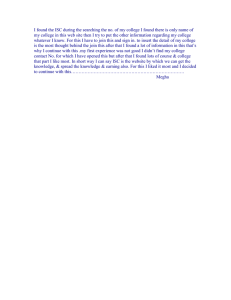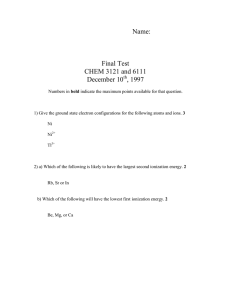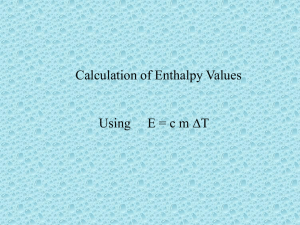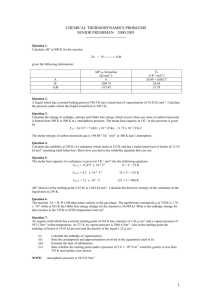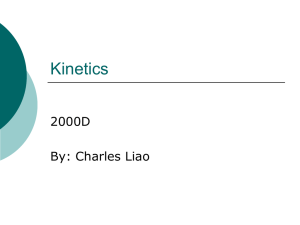Class XI Chemistry Specimen Question Paper ISC 2018
advertisement
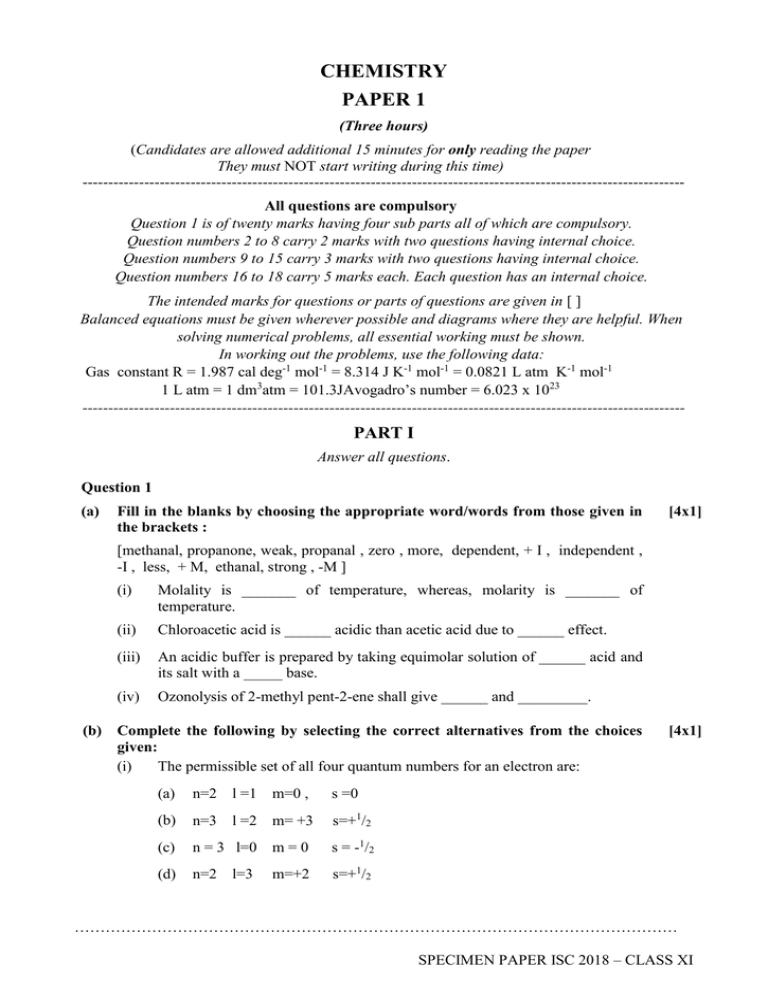
CHEMISTRY PAPER 1 (Three hours) (Candidates are allowed additional 15 minutes for only reading the paper They must NOT start writing during this time) --------------------------------------------------------------------------------------------------------------------All questions are compulsory Question 1 is of twenty marks having four sub parts all of which are compulsory. Question numbers 2 to 8 carry 2 marks with two questions having internal choice. Question numbers 9 to 15 carry 3 marks with two questions having internal choice. Question numbers 16 to 18 carry 5 marks each. Each question has an internal choice. The intended marks for questions or parts of questions are given in [ ] Balanced equations must be given wherever possible and diagrams where they are helpful. When solving numerical problems, all essential working must be shown. In working out the problems, use the following data: Gas constant R = 1.987 cal deg-1 mol-1 = 8.314 J K-1 mol-1 = 0.0821 L atm K-1 mol-1 1 L atm = 1 dm3atm = 101.3JAvogadro’s number = 6.023 x 1023 --------------------------------------------------------------------------------------------------------------------- PART I Answer all questions. Question 1 (a) Fill in the blanks by choosing the appropriate word/words from those given in the brackets : [4x1] [methanal, propanone, weak, propanal , zero , more, dependent, + I , independent , -I , less, + M, ethanal, strong , -M ] (i) Molality is _______ of temperature, whereas, molarity is _______ of temperature. (ii) Chloroacetic acid is ______ acidic than acetic acid due to ______ effect. (iii) An acidic buffer is prepared by taking equimolar solution of ______ acid and its salt with a _____ base. (iv) Ozonolysis of 2-methyl pent-2-ene shall give ______ and _________. (b) Complete the following by selecting the correct alternatives from the choices given: (i) The permissible set of all four quantum numbers for an electron are: (a) n=2 l =1 m=0 , s =0 (b) n=3 l =2 m= +3 s=+1/2 (c) n = 3 l=0 m=0 s = -1/2 (d) n=2 m=+2 s=+1/2 l=3 [4x1] ……………………………………………………………………………………………………… SPECIMEN PAPER ISC 2018 – CLASS XI (ii) (iii) (iv) (c) The order of electron gain enthalpy for halogens is: (a) F > Cl > Br> I (b) I > Br > Cl > F (c) I > Cl > Br > F (d) Cl > F > Br > I Which of the following conditions will favour the formation of ammonia in the reaction N2 + 3H22NH3 Δ H = -ve. (a) Increase in temperature (b) Decrease in temperature (c) Decrease in pressure (d) Addition of ammonia in the reaction vessel The rate of reaction gets doubled in the reaction R-X + OH-(aq) ROH + Xwhen the concentration of alkyl halide is doubled, but remains same when the concentration of the base is doubled.The alkyl halide is: (a) 2-chloro- 2- methyl propane (b) 2- chloropropane (c) Methyl chloride (d) 1-chloropropane Match the following: [4x1] (i) Octahedral Organic peroxides (ii) Diffusion of gases SF6 (iii) Kjeldahl’s method Graham (iv) Kharasch effect Nitrogen (d) Answer the following questions: (i) (ii) (iii) (iv) [4x2] (a) State Heisenberg’s Uncertainty Principle. (b) Write the electronic configuration of Cr [Z = 24]. What is the reason for abnormal electronic configuration of Cr? Explain the following: (a) Potassium carbonate cannot be prepared by Solvay’s method. (b) MgCO3 is more soluble in water than BaCO3. (a) Calculate the pH value of 2.1 x 10-3 M NaOH at 298 K. (b) Calculate the oxidation number of the following underlined elements: (1) S2O32- (2) H2O2. (a) Explain why but-1-ene does not exhibit geometrical isomerism. (b) Draw the optical isomers of 2-chlorobutane. ………………………………………………………………………………………………………… SPECIMEN PAPER ISC 2018 – CLASS XI PART II [2] Question 2 Write the electronic configuration of following elements /ions using aufbau’s principle: (i) Fe2+ [Z=26] (ii) Hg [Z=80] (iii) I [Z=53] (iv) Sr [Z=38] OR What is the maximum number of electrons that can be accommodated in the subshell represented by following set of quantum numbers: (i) n=2 , l =1 (ii) n=5, l=3 (iii) n=3 , l=2 (iv) n=6 , l=0 Question 3 [2] The first ionization enthalpy (ΔH1), the second ionization enthalpy (ΔH2) and the electron gain enthalpy (ΔHeg) of a few elements is given below: Element (ΔH1) (KJ mol-1) (ΔH2) (KJ mol-1) (ΔHeg) (KJ mol-1) A 525 7300 +50 B 1642 3374 -328 C 924 1846 -295 D 2520 5251 - 600 Which of the above elements is likely to be: (a) An alkali metal (Group I element) (b) A halogen (Group 17 element) Justify your answer in (a) and (b) above. ……………………………………………………………………………………………………… SPECIMEN PAPER ISC 2018 – CLASS XI [2] Question 4 (a) Complete and balance the following equation: MnO4- + H+ + H2O2 (b) Draw the structure of H2O2 in gaseous state. Question 5 [2] The heat of formation of CO2 and H2O is – 395 kJ mol-1 and – 285 kJ mol-1 respectively. The heat of combustion of glucose is – 2900 kJ mol-1. Calculate the heat of formation of glucose. Question 6 [2] Calculate the temperature at which 28 grams of N2 will occupy a volume of 10 L at 2.46 atm [at wt of N = 14]. Question 7 [2] (a) State any two uses of Plaster of Paris. (b) The melting point of LiF is more than LiI. Explain. OR How is sodium hydroxide prepared commercially by Castner-Kellner cell? [2] Question 8 Write the IUPAC name of the following: (a) CH3 – C= CH – CH2 – C – CH3 CH3 (b) O OH COOH ………………………………………………………………………………………………………… SPECIMEN PAPER ISC 2018 – CLASS XI [3] Question 9 (a) (b) Identify the limiting reagent in the following: (i) 5 moles of N2 reacts with 10 moles of H2 in Habers Process. (ii) 20 moles of SO2 reacts with 15 moles of O2 in Contact Process. What mass of MnO2 is required to react with 250 ml of 0.5 M HCl in the reation given below; MnO2 + 4HCl MnCl2 + 2H2O + Cl2 [at. wt. of Mn = 55, O = 16, Cl=35.5, H=1] OR Commercially prepared HCl is 38 % percent by mass. Density is 1.19 g cm-3. Calculate the following: (i) Molality of HCl solution (ii) Molarity of HCl solution (iii) Mole fraction of HCl in the solution [at wt of Cl = 35.5, H=1] Question 10 [3] The enthalpy change (ΔH) and entropy (ΔS) change for a reaction are 30.54 kJ mol-1 and 0.06 kJmol-1respectively. Calculate the temperature at equilibrium. Also predict the spontaneity below the temperature at which Gibb’s free energy is zero. Justify your answer with valid reason. [3] Question 11 Write balanced equations for the following conversions. (a) Propene to 2- bromopropane. (b) Phenol to toluene. (c) Methyl chloride to ethane. [3] Question 12 (a) List any two gases responsible for greenhouse effect. (b) List any two green chemistry approaches to reduce waste generation. (c) List any two gasses which cause acid rain. ……………………………………………………………………………………………………… SPECIMEN PAPER ISC 2018 – CLASS XI Question 13 [3] Draw a pair of possible isomers and mention the type of isomerism for each of the following: (a) C3H6O2 (b) C4H6 (c) C2H4O OR Write the type of attacking reagent and the type of reaction for the following : (a) Nitration of benzene to give nitrobenzene. (b) HCN reacted with acetaldehyde to form acetaldehyde cyanohydrin. (c) Ethyl bromide with alcoholic KOH. [3] Question 14 (a) The solubility product of silver chloride is 1.0 x 10-10 at 250C. Calculate the solubility of silver chloride in: (i) pure water (ii) (b) 0.2 M sodium chloride 10 moles of N2 is mixed with 14 moles of H2 in 6 L cylinder. 4.2 moles of ammonia is formed. Calculate Kc for the equation : N2 + 3H2 === 2 NH3 [3] Question 15 Balance the equation given below by ion-electron method. Justify your answer by suitable half cell equation: Cr2O72- + Fe2+ Cr3+ + Fe3+ [acidic medium]. [5] Question 16 (a) Answer the following : (i) Mention the hybridisation of underlined Carbon atom: CH3CHO,CH3COOH (ii) Show the coordinate bonding in perchloric acid (HClO4) with a suitable diagram. ………………………………………………………………………………………………………… SPECIMEN PAPER ISC 2018 – CLASS XI (b) Explain why the bond angle of ammonia is less than that of methane although both are sp3 hybridised. (c) (i) Draw the molecular orbital diagram for O2+. (ii) Explain the reason for O2+ being more reactive than O2. OR (a) (b) (c) Mention the hybridisation of central atom of the following molecules. Draw the structures showing the lone pair also. (i) ClF3 (ii) XeF4 Explain the following:(i) Bond enthalpy of C=C is not double than that of C - C bond. (ii) Despite being an organic covalent compound, ethyl alcohol is highly soluble in water. Calculate the number of sigma and pi bonds in the compound 2,3 dimethyl but-2-ene. Question 17 (a) Explain the following: [5] (i) (b) Though carbon and lead belong to the same family, carbon forms CCl4 whereas in case of lead, PbCl2 is more stable than PbCl4. (ii) AlCl3 is a Lewis acid. How is boric acid (H3BO3) prepared from borax? (c) State the types of hybridisation of carbon in diamond and graphite. (d) State the number of six membered and five membered rings in C60 (Buckminister fullerene). OR Explain the following: (a) (i) Catenation is maximum in carbon as compared to other group 14 elements. (ii) Graphite is used as a lubricant. (b) (iii) Inhaling CO is poisonous. How is silicon carbide (SiC) prepared from silica (SiO2)? (c) Why is CO2 a gas while SiO2 a solid? Explain. ……………………………………………………………………………………………………… SPECIMEN PAPER ISC 2018 – CLASS XI Question 18 (a) Mention a good chemical test used to distinguish between the following pairs of compounds: (i) But-1-yne and but-2-yne (ii) Ethene and ethane (b) Write balanced equation for Friedel-Craft acylation. (c) Identify the compounds A and B Conc. HNO3 CaO A C6H5COONa+ NaOH Heat [5] B Conc. H2SO4 . (a) (b) (c) (d) OR How will you convert acetylene to but-2-yne. Which is the major product obtained when 2-bromo butane is treated with alcoholic KOH? State the rule involved. Draw the resonating structures of phenol and explain why it influences the incoming electrophile to attack at ortho and para positions. Why is Corey- House reaction preferred for the preparation of propane as compared to the Wurtz reaction ? ………………………………………………………………………………………………………… SPECIMEN PAPER ISC 2018 – CLASS XI

